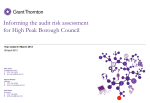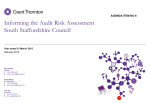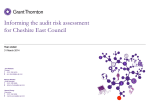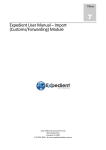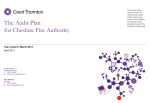Download The Audit Plan – template user guide
Transcript
Informing the audit risk assessment for Coventry City Council Year ended 31 March 2014 7 April 2014 John Gregory Engagement Lead T 0121 232 5333 E [email protected] Simon Turner Audit Manager T 0121 232 5273 E [email protected] Paul Harvey Executive T 0121 232 5329 E [email protected] © 2014 Grant Thornton UK LLP | Informing the risk assessment | April 14 . The contents of this report relate only to the matters which have come to our attention, which we believe need to be reported to you as part of our audit process. It is not a comprehensive record of all the relevant matters, which may be subject to change, and in particular we cannot be held responsible to you for reporting all of the risks which may affect your business or any weaknesses in your internal controls. This report has been prepared solely for your benefit and should not be quoted in whole or in part without our prior written consent. We do not accept any responsibility for any loss occasioned to any third party acting, or refraining from acting on the basis of the content of this report, as this report was not prepared for, nor intended for, any other purpose. . Contents Section Page Purpose 4 Fraud 5 Fraud risk assessment 6-7 Laws and regulations 8 Impact of laws and regulations 9 Going concern Going concern considerations Estimates Estimate considerations 10 11 – 12 13 14 - 19 Related parties 20 Related party considerations 21 © 2014 Grant Thornton UK LLP | Informing the risk assessment | April 14 Purpose The purpose of this report is to contribute towards the effective two-way communication between auditors and the Council's Audit and Procurement Committee , as 'those charged with governance'. The report covers some important areas of the auditor risk assessment where we are required to make inquiries of the Audit and Procurement Committee under auditing standards. Background Under International Standards on Auditing (UK and Ireland) (ISA(UK&I)) auditors have specific responsibilities to communicate with the Audit and Procurement Committee. ISA(UK&I) emphasise the importance of two-way communication between the auditor and the Audit and Procurement Committee and also specify matters that should be communicated. This two-way communication assists both the auditor and the Audit and Procurement Committee in understanding matters relating to the audit and developing a constructive working relationship. It also enables the auditor to obtain information relevant to the audit from the Audit and Procurement Committee and supports the Audit and Procurement Committee in fulfilling its responsibilities in relation to the financial reporting process. Communication As part of our risk assessment procedures we are required to obtain an understanding of management processes and the Audit and Procurement Committee's oversight of the following areas: • fraud • laws and regulations • going concern • accounting estimates • related party transactions This report includes a series of questions on each of these areas and the response we have received from the Council's management. The Audit and Procurement Committee should consider whether these responses are consistent with its understanding and whether there are any further comments it wishes to make. © 2014 Grant Thornton UK LLP | Informing the risk assessment | April 14 Fraud Issue Matters in relation to fraud ISA(UK&I)240 covers auditors responsibilities relating to fraud in an audit of financial statements. The primary responsibility to prevent and detect fraud rests with both the Audit and Procurement Committee and management. Management, with the oversight of the Audit and Procurement Committee, needs to ensure a strong emphasis on fraud prevention and deterrence and encourage a culture of honest and ethical behaviour. As part of its oversight, the Audit and Procurement Committee should consider the potential for override of controls and inappropriate influence over the financial reporting process. As auditor, we are responsible for obtaining reasonable assurance that the financial statements are free from material misstatement due to fraud or error. We are required to maintain professional scepticism throughout the audit, considering the potential for management override of controls. As part of our audit risk assessment procedures we are required to consider risks of fraud. This includes considering the arrangements management has put in place with regard to fraud risks including: • • • • assessment that the financial statements could be materially misstated due to fraud process for identifying and responding to risks of fraud, including any identified specific risks communication with the Audit and Procurement Committee regarding its processes for identifying and responding to risks of fraud communication to employees regarding business practices and ethical behaviour. We need to understand how the Audit and Procurement Committee oversees the above processes. We are also required to make inquiries of both management and the Audit and Procurement Committee as to their knowledge of any actual, suspected or alleged fraud. These areas have been set out in the fraud risk assessment questions below together with responses from the Council's management. © 2014 Grant Thornton UK LLP | Informing the risk assessment | April 14 Fraud risk assessment Question Management response Has the Council assessed the risk of material misstatement in the financial statements due to fraud? What are the results of this process? The work of Internal Audit is primarily focused on helping the Council manage the risks it is facing including the possibility of fraudulent activity. These are monitored through the reports and the follow up process. In addition, the Council has an auditor dedicated to corporate fraud and a Housing Benefit Fraud Team who focus on all aspects of fraud including awareness, proactive exercises looking at either fraud prevention and / or detection and investigations. What processes does the Council have in place to identify and respond to risks of fraud? The Council has a number of policies (e.g. Anti Fraud, Theft and Corruption Strategy, Anti-Money Laundering Policy, Confidential Reporting (whistleblowing) Policy, Financial Regulations, Codes of Conduct). These outline the responsibilities and channels for raising concerns and issues, and also the approach to be taken. The Internal Audit Plan also includes planned work on counter fraud and it is also implicit in audit work programmes. Have any specific fraud risks, or areas with a high risk of fraud, been identified and what has been done to mitigate these risks? Frauds have been reported to the Executive Director, Resources through his direct reporting lines. The details of these frauds have also been reported to the Audit and Procurement Committee in both public and private fraud reports during 2013/14. Are internal controls, including segregation of duties, in place and operating effectively? If not, where are the risk areas and what mitigating actions have been taken? Overall, the Internal Audit and Risk Manager's view is that the Council's internal control environment is generally effective in mitigating against the risk of fraud. However, when incidents occur, action taken includes reviewing controls and where appropriate making improvements. Are there any areas where there is a potential for override of controls or inappropriate influence over the financial reporting process (for example because of undue pressure to achieve financial targets)? The Council's performance management framework is based around targets so there is an expectation that both financial and operational targets are met. Pressure or incentives are not applied to deliver targets. Are there any areas where there is a potential for misreporting, override of controls or inappropriate influence over the financial reporting process? No, the auditing and financial monitoring controls in place would flag such issues up and there are no significant examples over recent reporting periods. © 2014 Grant Thornton UK LLP | Informing the risk assessment | April 14 Fraud risk assessment Question Management response How does the Audit and Procurement Committee exercise oversight over management's processes for identifying and responding to risks of fraud? What arrangements are in place to report fraud issues and risks to the Audit and Procurement Committee? The Audit & Procurement Committee receives reports on a six monthly basis covering the work of both the Corporate Fraud and Benefit Fraud Teams in respect of fraud activity. Whilst the nature of the work of the two services varies, it covers similar activities such as fraud awareness, proactive exercises (including data matching exercises) and investigations. Additionally, the Committee receives private reports on significant frauds that have occurred during the year. How does the Council communicate and encourage ethical behaviour of its staff and contractors? A key element in the Council's corporate fraud work is raising awareness in respect of what is acceptable behaviour as well as encouraging officers to report concerns to relevant managers / Internal Audit. Whilst it is acknowledged that this continues to be an area for development, relevant guidance has been produced and communicated including: • A Manager's Guide to Fraud Awareness aimed at assisting Council managers in both identifying and responding to fraud in their area. • An Employees' Guide to Fraud Awareness which provides a reference guide for employees' to quickly obtain information relating to fraud when it is relevant. • A summary of the key elements of the Code of Conduct for Employees focusing on reinforcing the standards and behaviours expected of Council employees. • A e-learning tool has also been developed to support fraud awareness and is included in the Council’s elearning system. How do you encourage staff to report their concerns about fraud? Have any significant issues been reported? The Council has a Whistleblowing Policy which is widely communicated and clarifies what type of concerns should be reported. No significant issues have been reported during 2013/14. Are you aware of any related party relationships or transactions that could give rise to risks of fraud? No. Mitigation takes place through controls that exist within the Council's payment process, e.g. segregation of duties. Also senior officers are required to make a declaration of interest around any potential conflicts which they may come into contact with as part of their job. Management action is then required to mitigate against the conflict arising. Are you aware of any instances of actual, suspected or alleged, fraud, either within the Council as a whole or within specific departments since 1 April 2013? Yes, frauds have been reported to the Executive Director, Resources through his direct reporting lines. The details of these frauds have also been reported to the Audit and Procurement Committee in both public and private fraud reports during 2013/14. © 2014 Grant Thornton UK LLP | Informing the risk assessment | April 14 Laws and regulations Issue Matters in relation to laws and regulations ISA(UK&I)250 requires us to consider the impact of laws and regulations in an audit of the financial statements. Management, with the oversight of the Audit and Procurement Committee, is responsible for ensuring that the Council's operations are conducted in accordance with laws and regulations including those that determine amounts in the financial statements. As auditor, we are responsible for obtaining reasonable assurance that the financial statements are free from material misstatement due to fraud or error, taking into account the appropriate legal and regulatory framework. As part of our risk assessment procedures we are required to make inquiries of management and the Audit and Procurement Committee as to whether the entity is in compliance with laws and regulations. Where we become aware of information of non-compliance or suspected non-compliance we need to gain an understanding of the non-compliance and the possible effect on the financial statements. Risk assessment questions have been set out below together with responses from management. © 2014 Grant Thornton UK LLP | Informing the risk assessment | April 14 Impact of laws and regulations Question Management response What arrangements does the Council have in place to prevent and detect non-compliance with laws and regulations? Verification of compliance with laws and regulations is implicit in many internal audit work programmes. Instances of non-compliance are brought to the attention of management through the standard reporting process. The Council also has an in-house legal team which works with service departments in ensuring that the Council complies with laws and regulations. How does management gain assurance that all relevant laws and regulations have been complied with? See above. How is the Audit and Procurement Committee provided with assurance that all relevant laws and regulations have been complied with? Following on from the above, the Audit and Procurement Committee within their quarterly reports receive summaries of Internal Audit reports where the level of assurance is either none or limited. This would include, where relevant, issues around noncompliance with law and regulations. Have there been any instances of non-compliance or suspected noncompliance with laws and regulations since 1 April 2013, or earlier with an on-going impact on the 2013/14 financial statements? Not aware of any instances of non-compliance with laws and regulations. What arrangements does the Council have in place to identify, evaluate and account for litigation or claims? Information from legal team and year end declaration from Directors and departments on contingent liabilities which specifically refer to legal disputes. Is there any actual or potential litigation or claims that would affect the financial statements? No significant pending issues. Have there been any reports from other regulatory bodies, such as HM Revenues and Customs which indicate non-compliance? There have not been any reports from other regulators that indicate non-compliance. © 2014 Grant Thornton UK LLP | Informing the risk assessment | April 14 Going concern Issue Matters in relation to going concern ISA(UK&I)570 covers auditor responsibilities in the audit of financial statements relating to management's use of the going concern assumption in the financial statements. The going concern assumption is a fundamental principle in the preparation of financial statements. Under this assumption entities are viewed as continuing in business for the foreseeable future. Assets and liabilities are recorded on the basis that the entity will be able to realise its assets and discharge its liabilities in the normal course of business. The code of practice on local authority accounting requires a Council's financial statements to be prepared on a going concern basis. Although the Council is not subject to the same future trading uncertainties as private sector entities, consideration of the key features of the going concern provides an indication of the Council's financial resilience. As auditor, we are responsible for considering the appropriateness of use of the going concern assumption in preparing the financial statements and to consider whether there are material uncertainties about the Council's ability to continue as a going concern that need to be disclosed in the financial statements. We discuss the going concern assumption with management and review the Council's financial and operating performance. Going concern considerations have been set out below and management has provided its response. © 2014 Grant Thornton UK LLP | Informing the risk assessment | April 14 Going concern considerations Question Management response Does the Council have procedures in place to assess the Council's ability to continue as a going concern? Going concern is considered on an annual basis as part of the preparation of the financial statements. This review considers key areas that impact on the Council's ability to continue as a going concern, e.g. financial resilience, contingent liabilities, budgets and medium term financial forecasts. Is management aware of the existence of other events or conditions that may cast doubt on the Council's ability to continue as a going concern? There are no events or conditions that impact on the Council's ability to continue as a going concern. Are arrangements in place to report the going concern assessment to the Audit and Procurement Committee? The Audit and Procurement Committee receives the Statement of Accounts annually for approval and this includes a summary of the assessment. Are the financial assumptions (e.g. future levels of income and expenditure) consistent with the Council's Business Plan and the financial information provided to the Council throughout the year? Yes, the budget assumptions feed through into the medium term financial forecast on a consistent basis. © 2014 Grant Thornton UK LLP | Informing the risk assessment | April 14 Going concern considerations Question Management response Are the implications of statutory or policy changes appropriately reflected in the Business Plan, financial forecasts and report on going concern? Yes the main changes currently relate to Welfare Reform and the local retention of Business Rates and both areas have been assessed and whilst they create challenges they do not affect the future viability of the Council. Have there been any significant issues raised with the Audit and Procurement Committee during the year which could cast doubts on the assumptions made? (Examples include adverse comments raised by internal and external audit regarding financial performance or significant weaknesses in systems of financial control). No significant issues raised. Does a review of available financial information identify any adverse financial indicators including negative cash flow? If so, what action is being taken to improve financial performance? No – the quarterly monitoring reports continue to indicate an outturn within budget. Does the Council have sufficient staff in post, with the appropriate skills and experience, particularly at senior manager level, to ensure the delivery of the Council’s objectives? If not, what action is being taken to obtain those skills? Yes © 2014 Grant Thornton UK LLP | Informing the risk assessment | April 14 Estimates Issue Matters in relation to accounting estimates ISA (UK&I) 540 covers auditor responsibilities relating to estimates in an audit of financial statements. Local authorities use estimates in the preparation of their financial statements. We need to obtain an understanding of • how management identifies the transactions, events and conditions that give rise to the need for an accounting estimate. • how management actually make the estimates, including the control procedures in place to minimise the risk of misstatement. We need to be aware of all estimates that the Council use as part of their accounts preparation. These are set out overleaf. © 2014 Grant Thornton UK LLP | Informing the risk assessment | April 14 Estimate considerations Underlying assumptions Estimate Method Controls used to identify estimates Use of an expert - Assessment of degree of uncertainty - Consideration of alternative estimates Change in accounting method in year? Property plant & equipment depreciation Depreciation is provided for Consistent application of Use of RICS The length of the life is determined at the point of No all fixed assets with a finite depreciation method across all valuer for acquisition or revaluation. useful life on a straight-line assets buildings. Major components are depreciated separately. basis Other assets in line with the Council's accounting policies Estimated remaining useful lives of PPE The following asset categories have general asset lives: • Buildings range • Equipment/ vehicles • Plant • Infrastructure Specific asset lives applied to Use RICS valuer The method makes some generalisations. For No buildings. for buildings. example, building lives would vary depending on the construction materials used. This life would be Consistent asset lives applied Other assets recorded in accordance with RICS valuation. to each asset category. considered by the Corporate Detailed information is included in the valuer's Capital Team. report for each asset. The asset live is then recorded in the asset register. © 2014 Grant Thornton UK LLP | Informing the risk assessment | April 14 Estimate considerations Underlying assumptions Estimate Impairments Finance lease liability Method Assets are assessed at the year-end for any indication that an asset may be impaired. Where indications exist and any possible differences are estimated to be material, the recoverable amount of the asset is estimated and, where this is less than the carrying amount of the asset, an impairment loss is recognised for the shortfall. At the inception of the lease the liability is the lower of the fair value of the asset or present value of the minimum lease payments. Payments are split between the finance charge and the element that reduces the liability. © 2014 Grant Thornton UK LLP | Informing the risk assessment | April 14 Controls used to identify estimates Use of an expert - Assessment of degree of uncertainty - Consideration of alternative estimates Change in accounting method in year? Assets are assessed External RICS Valuations are made in-line with RICS guidance - No at each year-end as to whether valuer. reliance on expert. there is any indication that an asset may be impaired. Other assets considered by This assessment is made by Corporate the valuer for land and Capital Team. buildings and corporate capital team (and other relevant officers for the asset type) for other assets. Finance review contracts and payments over the deminimus level to ensure the lease is categorised correctly as a finance lease or an operating lease. Calculations supported by lease documents. May obtain guidance to support lease classifications. Assets recognised under finance leases are accounted for using the policies applied generally to such assets, subject to depreciation being charged over the lease term if this is shorter than the asset’s estimated useful life (where ownership of the asset does not transfer to the Council at the end of the lease period). No Estimate considerations Underlying assumptions Estimate Non adjusting events - events after the BS date Allocation of overhead costs Pension liability Method Controls used to identify estimates Use of an expert S151 Officer makes the Managers notify the S151 This would be assessment. If the event is Officer considered on indicative of conditions that individual arose after the balance sheet date circumstances then this is an unadjusting event. For these events only a note to the accounts is included, identifying the nature of the event and where possible estimates of the financial effect The finance team apportion All support service No central support costs to services cost centres are allocated using specified bases as detailed according to the agreed in supporting analysis. principles. The Council is an admitted body Payroll data is provided to Consulting to the West Midlands the actuary. actuary Authorities Pension Fund. The Management reconcile administering authority this estimate of (Wolverhampton City Council) contributions to the engage the actuary who provides actuals paid out in the the estimate of the pension year. liability. © 2014 Grant Thornton UK LLP | Informing the risk assessment | April 14 - Assessment of degree of uncertainty - Consideration of alternative estimates This would be considered on individual circumstances Change in accounting method in year? N/A Apportionment bases are reviewed each year to No ensure that they remain appropriate and equitable As disclosed in the actuary's report. Complex No judgements including the discount rate used, rate at which salaries are projected to increase, changes in retirement ages, mortality rates and expected returns on pension fund assets. Estimate considerations Underlying assumptions Estimate Bad debt provision. Provisions for liabilities. Method Controls used to identify estimates Use of an expert A provision is estimated based on Budget holders review No the likelihood of the debts being bad debt provisions collected by the departmental before the departmental finance teams. return is submitted to corporate finance Provisions are made where an Equal pay provision is No event has taken place that gives reviewed by senior the Council a legal or constructive officers for obligation that probably requires reasonableness. settlement by a transfer of economic benefits or service Provisions from potential, and a reliable estimate departments are can be made of the amount of the reviewed by budget obligation. Provisions are charged holders prior to as an expense to the appropriate submission to corporate service line in the Consolidated finance. They are also Income & Expenditure Statement reviewed by corporate in the year that the Council finance for becomes aware of the obligation, reasonableness. and are measured at the best estimate at the balance sheet date of the expenditure required to settle the obligation, taking into account relevant risks and uncertainties. © 2014 Grant Thornton UK LLP | Informing the risk assessment | April 14 - Assessment of degree of uncertainty - Consideration of alternative estimates Change in accounting method in year? Consistent proportion used across aged debt as per No the Code. Estimated settlements are reviewed at the end of No each financial year – where it becomes less than probable that a transfer of economic benefits will now be required (or a lower settlement than anticipated is made), the provision is reversed and credited back to the relevant service. Where some or all of the payment required to settle a provision is expected to be recovered from another party (e.g. from an insurance claim), this is only recognised as income for the relevant service if it is virtually certain that reimbursement will be received by the Council. Estimate considerations Underlying assumptions Estimate Accruals Investments in companies valuations Method Finance team collate accruals of expenditure and income. Activity is accounted for in the financial year that it takes place, not when money is paid or received. Controls used to identify estimates Use of an expert Review of the No procurement system where goods have been received but not paid for. Requests of departmental finance teams to identify any other goods or services received or provided but not paid for. Estimates are made based on Valuations are prepared Birmingham the use of accepted valuation by corporate finance Airport and models. These are prepared by (excluding Birmingham Coventry & the Council based on the Airport and Coventry Solihull Waste audited financial statements of & Solihull Waste Disposal the companies. Disposal Company ). Company These are subject to investment is review by another reviewed by Birmingham Airport and member of corporate BDO Coventry & Solihull Waste finance. Disposal Company valuations to Birmingham Airport be prepared by Solihull MBC and Coventry & and reviewed by an expert. Solihull Waste Disposal Company valuations will be based on the external valuation. © 2014 Grant Thornton UK LLP | Informing the risk assessment | April 14 - Assessment of degree of uncertainty - Consideration of alternative estimates Change in accounting method in year? Accruals for income and expenditure often based No on known values. Where accruals are estimated the latest available information is used. In-house valuations place weightings on the share percentage and potential resale value of the shares. Birmingham Airport valuation based on business plan and forecasted income / expenditure No Estimate considerations Estimate Group company asset valuations Long term obligations under PFI schemes Method Controls used to identify estimates Use of an expert PPE assets of group companies 2010/11 valuations reviewed Yes are re-valued to fair value to by corporate finance team to comply with IFRS. ensure that they are still applicable. Valuations have been undertaken by management's Use of management expert experts in 2010/11 and will be for Coventry & Solihull Waste revisited in 2013/14 for Disposal Company. Coventry & Solihull Waste Disposal Company. These are reviewed to ensure that there are no impairments that affect the valuations. The Council controls the services and residual interest in its PFI contracts, and therefore has assessed these arrangements under IFRIC 12 ‘Service Concessions’ – recognising the assets used to deliver the services on the Council’s balance sheet along with a corresponding liability. © 2014 Grant Thornton UK LLP | Informing the risk assessment | April 14 The Council’s IFRIC 12 None working model is used to calculate the relevant IFRIC 12 accounting entries. It is a model developed by Grant Thornton and figures have been input by the Council’s Special Projects Finance department. The accounts have been prepared by the Council’s Corporate Finance department. Underlying assumptions - Assessment of degree of uncertainty - Consideration of alternative estimates Change in accounting method in year? Assumptions on whether market circumstances have changed since the formal valuations in 2010/11. No The initial recognition of the asset/liability is based on costs within the operator’s financial model, and the embedded finance lease repayments are estimated by deducting service and lifecycle costs from the Unitary Charge. There is also a ‘future obligation’s disclosure requirement for IFRIC 12 arrangements, in which the unitary charge is divided between service and lifecycle costs, and lease capital and interest elements. The finance lease aspect is based on the model described above, and the unitary charge, service charge and lifecycle costs are based on assumptions about the future inflation rates. No Related parties Issue Matters in relation to related parties ISA (UK&I) 550 covers auditor responsibilities relating to related party transactions. Many related party transactions are in the normal course of business and may not carry a higher risk of material misstatement. However in some circumstances the nature of the relationships and transaction may give rise to higher risks. For local government bodies, the Code of Practice on Local Authority Accounting in the United Kingdom (the Code) requires compliance with IAS 24: related party disclosures. The Code identifies the following as related parties to local government bodies: • entities that directly, or indirectly through one or more intermediaries, control, or are controlled by the Council (i.e. subsidiaries) • associates • joint ventures in which the Council is a venturer • an entity that has an interest in the Council that gives it significant influence over the Council • key officers, and close members of the family of key officers • post-employment benefit plan (pension fund) for the benefit of employees of the Council, or of any entity that is a related party of the Council. The Code notes that, in considering materiality, regard should be had to the definition of materiality, which requires materiality to be judged from the viewpoint of both the Council and the related party. ISA (UK&I) 550 requires us to review your procedures for identifying related party transactions and obtain an understanding of the controls that you have established to identify such transactions. We will also carry out testing to ensure the related party transaction disclosures you make in the financial statements are complete and accurate. © 2014 Grant Thornton UK LLP | Informing the risk assessment | April 14 Related party considerations Question Management response Who are the Council's related parties? This will be determined as part of the preparation of the financial statements. What are the controls in place to identify, account for, and disclose, related party transactions and relationships? A number of arrangements are in place for identifying the nature of a related party and reported value including: ■ maintenance of a register of interests for members, a register for pecuniary interests in contracts for officers and senior managers requiring disclosure of related party transactions. ■ annual return from senior managers/officers requiring confirmation that they have read and understood the declaration requirements and stating details of any known related party interests. ■ review of in-year income and expenditure transactions with known identified related parties from prior year or known history. ■ review of related information with subsidiaries, companies and joint ventures, e.g. accounts. ■ review of the accounts payable and receivable systems and identification of amounts paid to/from assisted or voluntary organisation ■ review of year end debtor and creditor positions in relation to the related parties identified. ■ review of minutes of decision making meetings to identify any member declarations and therefore related parties. © 2014 Grant Thornton UK LLP | Informing the risk assessment | April 14 © 2014 Grant Thornton UK LLP. All rights reserved. 'Grant Thornton' means Grant Thornton UK LLP, a limited liability partnership. Grant Thornton is a member firm of Grant Thornton International Ltd (Grant Thornton International). References to 'Grant Thornton' are to the brand under which the Grant Thornton member firms operate and refer to one or more member firms, as the context requires. Grant Thornton International and the member firms are not a worldwide partnership. Services are delivered independently by member firms, which are not responsible for the services or activities of one another. Grant Thornton International does not provide services to clients. grant-thornton.co.uk























